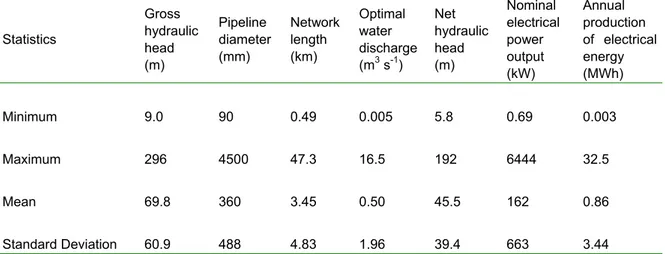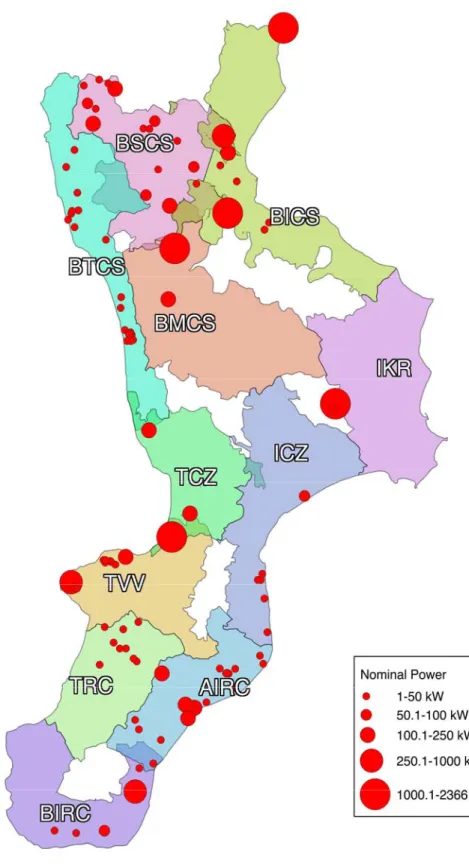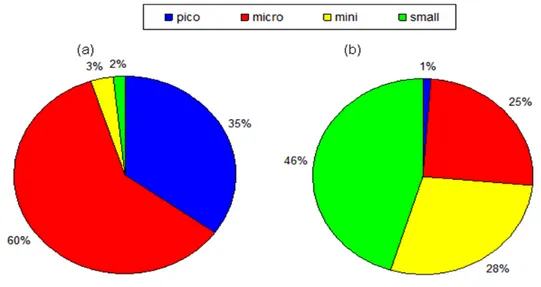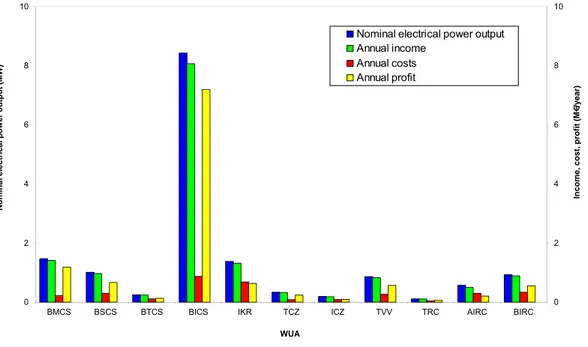CHEMICAL ENGINEERING
TRANSACTIONS
VOL. 58, 2017
A publication of
The Italian Association of Chemical Engineering Online at www.aidic.it/cet
Guest Editors: Remigio Berruto, Pietro Catania, Mariangela Vallone Copyright © 2017, AIDIC Servizi S.r.l.
ISBN 978-88-95608-52-5; ISSN 2283-9216
Energy Production by Small Hydro Power Plants in Collective
Irrigation Systems of Calabria (Southern Italy)
Demetrio A. Zema
*, Angelo Nicotra, Vincenzo Tamburino, Santo M. Zimbone
“Mediterranea” University of Reggio Calabria, Department “AGRARIA”, Località Feo di Vito, I-89122 Reggio Calabria, Italy [email protected]In Water Users Associations (WUA) of Calabria (Southern Italy) considerable geodetic heads and water flows are available in collective irrigation networks. Therefore it is possible to produce electrical energy by hydro-turbines out of the irrigation season, preferably by small hydro power (SHP) plants. Applying at the regional scale a previously developed model to evaluate the technical and economic feasibility of SHP plants in existing irrigation systems, this paper estimates the theoretical energy production and the economic performances of SHP plants installed in the WUAs operating in Calabria. In the 120 water systems surveyed, a total electrical power output of 15.5 MW could theoretically be produced, preferably by plants with nominal power output in the range 5 - 100 kW. The planned SHP plants would provide a total annual profit of about 11.5 M€, which would triple the annual WUA income. The annual sustainability of SHP maintenance, operation and management costs is also demonstrated.
1. Introduction
Hydropower is one of the most cost-effective energy technologies with a large prospect for future development of renewable energy sector in Europe (Paish, 2002). However, organizations are discouraging countries in developing large scale power plants while enhancing small hydro power (SHP), due to environmental and social factors (Yah et al., 2017). SHP plants, showing easy operation and maintenance, cheap electricity generation prices and environmentally sustainability (Laghari et al., 2013; Yah et al., 2017), are considered excellent options for rural electrification in remote and decentralised areas, characterized by proper potential or existing irrigation systems (Cavazzini et al., 2016). In these water networks, the availability of considerable geodetic heads and water flows suggests the possibility of electrical energy production by turbines out of the irrigation season. This is the case of many Water Users Associations (WUAs), where the potential energy of collective irrigation networks can be exploited at sustainable costs and the annual income can be increased through additional revenues (Zema et al., 2016). Among the regions of Southern Italy, where irrigation water is prevalently managed in collective forms, Calabria has a considerably high number of suitable sites for the installation of SHP plants in existing collective irrigation systems, because of the morphological characteristics of its territory (several water bodies, as torrents, lakes, reservoirs, located in the mountainous areas). However, very few Calabrian WUAs have installed SHP plants in their irrigation networks and thus in this region the potential energy is practically fully lost.
This paper estimates the theoretical energy production and the economic performances of SHP plants installed in collective irrigation networks of Calabrian WUAs. To these aims, a previously developed method (Zema et al., 2016), able to site turbines, choose their power output, and evaluate profits, is applied at the regional scale, in order to give energy managers and WUAs' authorities insights on how to evaluate the technical and economic feasibility of small turbines in existing irrigation systems.
2. Materials and methods
Referring more detailed information to the original paper of Zema et al. (2016), the proposed method is summarized here. Maps and longitudinal profiles of the 120 irrigation systems operating in the 11 WUAs of Calabria were processed. Hydraulic calculations provided the net hydraulic heads (ΔHn), the corresponding
DOI: 10.3303/CET1758088
Please cite this article as: Zema D.A., Nicotra A., Tamburino V., Zimbone S.M., 2017, Energy production by small hydro power plants in collective irrigation systems of calabria (southern italy), Chemical Engineering Transactions, 58, 523-528 DOI: 10.3303/CET1758088
optimal discharge (Q*) and thus the maximum power output (Pn) of turbines. In this study, neither adjustments of the water networks were planned nor civil works to increase the diameter of water supplying lines, because the pipeline replacement cost is not balanced by a corresponding increase of income from electrical energy production (Zema et al., 2016).
The economic viability of SHP plants was evaluated, estimating for a plant lifespan of 25 years and an annual operation time of 5760 hours (corresponding to eight months of operation out of the irrigation season): (i) Incomes (I), calculated by the unit subsidies to renewable energy production, according to the Italian rules, for the first 20 years, and without subsidies for the remaining five years; (ii) Investment Costs (IC), sum of Civil and Electro-Mechanical Equipment Costs, Power Transmission Line Costs, Engineering and Design Costs and Supervision and Administration Costs; (iii) Annual Costs (AC), sum of Depreciation of Equipment Costs, Operating and Maintenance Costs, Replacement and Renovation Costs, Financial Charges, Taxes on Income, Residual Price and Transport and Disposal Costs.
The SHP plant profit was estimated calculating the average Return per Unit of produced Energy (RUE, that is the ratio between the annual profit from electricity sale and the annual energy yield) by subtracting IC and AC from I and dividing the result by the annual energy production. Incomes, costs and profits from energy production by SHP plants were then compared with the annual budgets of the studied WUAs (excluding the WUA "BTCS", which denied financial data).
Finally, the map of the theoretical energy production by SHP plants in collective irrigation networks of Calabria was drawn.
3. Results and discussions
In the 120 irrigation systems surveyed in the WUAs of Calabria the available ΔHn are in the range 5.8 - 192 m (on the average 45.5 m), while Q* varies between 5 L s-1 and 16.5 m3 s-1 (with a mean value of 0.5 m3 s-1).
Based on these hydraulic parameters, SHP plants with Pn from 0.69 kW to 6.44 MW could be installed (on the average Pn = 162 kW) (Table 1).
However, since Zema et al. (2016) demonstrated that turbines with Pn < 5 kW have a marginal profitability, this size has been considered as the lowest threshold for the planned SHP plants. Based on these data, the SHP plant installation in the existing irrigation systems of Calabria would provide a total electric power of 15.53 MW, producing 78.3 GWh per year, with turbines operating only out of the irrigation season.
Table 1 - Main characteristics of the collective irrigation systems for SHP plant installation in Calabria (n = 120). Statistics Gross hydraulic head (m) Pipeline diameter (mm) Network length (km) Optimal water discharge (m3 s-1) Net hydraulic head (m) Nominal electrical power output (kW) Annual production of electrical energy (MWh) Minimum 9.0 90 0.49 0.005 5.8 0.69 0.003 Maximum 296 4500 47.3 16.5 192 6444 32.5 Mean 69.8 360 3.45 0.50 45.5 162 0.86 Standard Deviation 60.9 488 4.83 1.96 39.4 663 3.44 Figure 1 illustrates the territorial distribution of SHP plants planned in the existing irrigation systems of the WUAs in Calabria. This map shows that the highest concentration of SHP plants falls in mountain areas of "Pollino" chain (in northern Calabria), with three plants of nominal power higher than 1 MW. In the WUA "IKR" only one plant can be planned, while in the majority of WUAs many plants of small power (5 - 250 kW) can be installed (e.g. "TRC", "BTCS", "BSCS").
Figure 2 - Distribution of the number (a) and cumulated nominal power output (b) of SHP plants in collective irrigation systems of Calabria.
According to the plant classification proposed by Paish (2002), 35% of SHPs are pico plants (Pn < 10 kW), while 60% are micro plants (10 kW < Pn < 500 kW); only 3% and 2% of the planned SHPs are mini (500 kW < Pn < 2 MW) and small (2 MW < Pn < 10 MW) plants, respectively. None of these SHPs has Pn> 10 MW (Figure 2a). As regards the cumulated power output, Pn derives by 46% from small plants, by 28% from mini plants and by 25% from micro plants, while pico plants produce only 1% of the regional power output (Figure 2b)
.
The analysis of SHP profitability shows a RUE in the range 0.135 - 0.172 € kWh-1 with a mean value of 0.161
€ kWh-1. If RUE is regressed against Pn, a lower convenience of turbines with power output higher than 75 -
100 kW is found compared to the smaller size of plants, as shown by the very low increase of RUE when Pn raises over this range (Figure 3).
Figure 3 - Return per unit of energy produced against nominal electrical power output of SHP plants in collective irrigation systems of Calabria.
0,12 0,13 0,14 0,15 0,16 0,17 0,18 1 10 100 1000 10000
Nominal electrical power output (kW)
Retu rn p e r un it of energy p rod uced (€/kW h )
Therefore, it is particularly convenient to install plants with 5 < Pn< 100 kW; nevertheless, installation of mini and small turbines (Pn> 500 kW) is also advisable considering their incidence over the regional total energy productivity.
Figure 4 reports the total annual income, costs and profit of energy production by SHP planned in irrigation systems of Calabrian WUAs. Turbines with Pn< 5 kW (22 SHP plants) and plants requiring civil works (since the related costs may be currently not sustainable by the Calabrian WUAs, also asking for loans) have not been considered. Accordingly to Pn installed, the maximum income is found for "BICS" (with a profit over 7 M€ per year), while the lowest for "BTCS", "TCZ", "ICZ" and "TRC".
Figure 4 - Total nominal electrical power output and annual income, costs and profit of SHP plants in collective irrigation systems of Calabria.
Figure 5 - Economic evaluation of profitability of SHP plants in collective irrigation systems of Calabria. 0 2 4 6 8 10 0 2 4 6 8 10
BMCS BSCS BTCS BICS IKR TCZ ICZ TVV TRC AIRC BIRC
Income, cost , pr of it ( M €/ y ear ) Nomi nal el ect ri cal po w er out put ( M W ) WUA
Nominal electrical power output Annual income Annual costs Annual profit 0 10 20 30 40 50 0 200 400 600 800 1000 1200
BMCS BSCS BTCS BICS IKR TCZ ICZ TVV TRC AIRC BIRC
A nnual serv ice M O M costs/ann ua l SHP M O M costs (% ) SHP annual profit/G ross Rev e nue Collected (% ) WUA
SHP annual profit/Gross Revenue Collected Total service MOM costs/total SHP MOM costs
Globally, the installation of small turbines in existing irrigation systems of WUAs would provide in Calabria an annual income of about 14.8 M€ against a annual costs (amortisation + management, operation and maintenance, “MOM”) of about 3.3 M€. Therefore, the total annual profit is equal to about 11.5 M€ (Figure 4). This outcome is important considering the annual budgets of the Calabrian WUAs. As a matter of fact, the annual profit of energy production by SHP is on the average more than 3-fold the Gross Revenues Collected (GRC) (that is, the incomes from collective irrigation and drainage services) each year by the WUAs in Calabria (globally equal to about 3.4 M€); for the WUA "BMCS" the profit is even 11-fold the GRC (Figure 5). The lowest incidence of SHP operations on the annual budgets is found for the WUAs "ICZ" and "TVV". Moreover, it is interesting to note that annual MOM costs of SHP plants cover a limited share of the annual MOM costs supported by the WUAs to operate the collective irrigation and drainage services (from 4 to 47%, with an average value of 21%), thus confirming the annual sustainability of SHP operations (Figure 5).
Overall, although a deeper analysis is required to detail the subsequent design steps prior to SHP plants implementation at the regional scale, this study has shown the convenience to recover the considerable potential energy available in the collective water networks of Calabrian WUAs by small turbines operating out of the irrigation season.
4. Conclusions
This study has evaluated the technical and economic feasibility of SHP plant installation in the existing collective irrigation networks of WUAs in Calabria, in view of providing additional economic revenues for these associations and enhancing the exploitation of a renewable energy source. In the 120 irrigation systems surveyed the SHP plant installation would provide a total electric power output of 15.5 MW, producing 78.3 GWh per year, with turbines operating only out of the irrigation season (about eight months per year). Their size is mainly (60% of the total number of turbines) typical of micro plants. Pico plants (35%) would produce only 1% of the regional power output
.
The analysis has shown that it is particularly convenient to install plants with 5 < Pn< 100 kW, even though mini and small turbines would increase significantly the regional energy production. The annual profit of energy production by SHP is on the average more than 3-fold the annual income of the collective services provided by the WUAs; MOM costs of SHP plants are sustainable, since it represents on the average 21% of annual MOM costs of the collective irrigation and drainage services.List of acronyms of Water Users Associations
BSCS: Bacini Settentrionali del Cosentino BMSC: Bacini Meridionali del Cosentino BTCS: Bacini del Tirreno Cosentino BICS: Bacini dello Ionio Cosentino IKR: Ionio Crotonese
ICZ: Ionio Catanzarese TCZ: Tirreno Catanzarese TVV: Tirreno Vibonese TRC: Tirreno Reggino AIRC: Alto Ionio Reggino BIRC: Basso Ionio Reggino
References
Cavazzini G., Santolin A., Pavesi G., Ardizzon G., 2016, Accurate estimation model for small and micro hydropower plants costs in hybrid energy systems modelling, Energy 103, 746-757.
Laghari J.A., Mokhlis H., Bakar A.H.A., Hasmaini M., 2013, A comprehensive overview of new designs in the hydraulic, electrical equipments and controllers of mini hydro power plants making it cost effective technology, Renewable and Sustainable Energy Reviews 20, 279-293.
Paish O., 2002, Small hydro power: technology and current status, Renewable and Sustainable Energy Reviews 6, 537-556.
Yah N.F., Oumer A.N., Idris M.S., 2017, Small scale hydro-power as a source of renewable energy in Malaysia: A review, Renewable and Sustainable Energy Reviews 72, 228–239.
Zema D.A., Nicotra A., Tamburino V., Zimbone S.M., 2016, A simple method to evaluate the technical and economic feasibility of micro hydro power plants in existing irrigation systems, Renewable Energy 85, 498-506.



